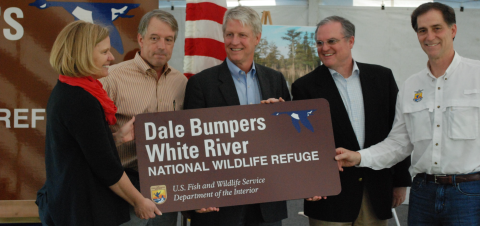About Us
Dale Bumpers White River National Wildlife Refuge was established on September 5, 1935 by President Franklin D. Roosevelt with the purpose to protect and conserve migratory birds and other wildlife resources. It is one of the most important areas for wintering waterfowl in North America. The refuge is home to the only population of native black bears in the state of Arkansas, and is designated as a Wetland of International Importance. Dale Bumpers White River NWR annually attracts approximately 455,000 visits from hunters, anglers, bird watchers, and others. The refuge lies within the floodplain of the White River, near where it meets the mighty Mississippi River. Long, narrow, and varying from a quarter mile to ten miles wide and approximately sixty miles long, the refuge is one of the largest remaining bottomland hardwood forests in the Mississippi River Valley. Its fertile forests and some three hundred lakes are interlaced with streams, sloughs, and bayous. These habitats are a haven for a myriad of native wildlife and migratory birds.
Our History
Thanks to the passage of the Migratory Bird Hunting and Conservation Stamp Act in 1934, refuge lands would eventually be purchased and managed by the Bureau of Biological Survey as an inviolate migratory bird sanctuary. On September 5, 1935, the White River Migratory Waterfowl Refuge was established by Executive Order 7173 by President Franklin D. Roosevelt. Soon thereafter, the Bureau of Biological Survey was transferred to the Department of the Interior and the U.S. Fish and Wildlife Service was created. This ultimately led to the name of the refuge changing from the White River Migratory Waterfowl Refuge to the White River National Wildlife Refuge.
On April 18, 2014, the refuge was renamed to Dale Bumpers White River National Wildlife Refuge in honor of the former Arkansas governor and four-term U.S. Senator, Dale Bumpers. “The Service is proud to recognize the many contributions Senator Bumpers has made to give many future generations the same opportunity to enjoy Arkansas’ natural beauty as we have had,” U.S. Fish and Wildlife Service Director Dan Ashe said. “He is a giant among conservationists and a visionary who followed an unconventional path to set aside some of Arkansas’ last wild places. It is fitting that he will be forever linked with the White River.”
Read more about the history of the refuge here: Dale Bumpers White River NWR - General Brochure

